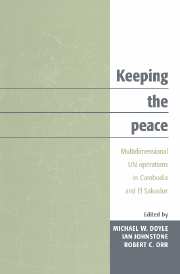Book contents
- Frontmatter
- Contents
- Preface
- Notes on the contributors
- List of abbreviations
- 1 Introduction
- Cambodia
- Map
- 2 Three visions of politics in Cambodia
- 3 The political dynamics of the peacemaking process in Cambodia
- 4 The Cambodian Settlement Agreements
- 5 Holding a fragile peace: the military and civilian components of UNTAC
- 6 Authority and elections in Cambodia
- 7 Returning home: the repatriation of Cambodian refugees
- 8 Quick impacts, slow rehabilitation in Cambodia
- El Salvador
- Conclusion and chronologies
- Select bibliography
- Index
5 - Holding a fragile peace: the military and civilian components of UNTAC
Published online by Cambridge University Press: 22 October 2009
- Frontmatter
- Contents
- Preface
- Notes on the contributors
- List of abbreviations
- 1 Introduction
- Cambodia
- Map
- 2 Three visions of politics in Cambodia
- 3 The political dynamics of the peacemaking process in Cambodia
- 4 The Cambodian Settlement Agreements
- 5 Holding a fragile peace: the military and civilian components of UNTAC
- 6 Authority and elections in Cambodia
- 7 Returning home: the repatriation of Cambodian refugees
- 8 Quick impacts, slow rehabilitation in Cambodia
- El Salvador
- Conclusion and chronologies
- Select bibliography
- Index
Summary
Introduction
The destructiveness of the Cambodian conflict was directly proportional to the level of arms available to its factional armies, who had continuously used military force to intimidate the Cambodian people. Thus, the Military Component (MILCOM) of the United Nations Transitional Authority in Cambodia (UNTAC), was to play a critical role in the creation of a “neutral political environment” through its monitoring of ceasefire, disarmament, regroupment, cantonment, and demobilization of factional forces. Though UNTAC included several civilian components, it was the deployment of armed UN soldiers which distinguished UNTAC as a peacekeeping mission.
Complementing the work of MILCOM, the Civilian Police Component (CIVPOL), was tasked with stabilizing the security situation. The seed for a UN police presence in Cambodia was first sown in the “Australian plan,” which suggested that the CIVPOL presence in Namibia had been “more significant than the military presence in encouraging a sense of day-to-day security and impartiality in running the country,” and advocated a significant police monitoring presence in Cambodia.
This chapter will review the mandates of MILCOM and CIVPOL according to the Paris Peace Agreements and examine their execution. The final section will examine lessons suggested by the UN's experience in Cambodia.
The mandate
The military component
The military functions of UNTAC included: monitoring and verifying ceasefire between factions; supervising, monitoring, and verifying the withdrawal of all foreign forces; monitoring the cessation of all outside military assistance to the Cambodian factions; and most critically, the regroupment, cantonment, disarmament, and demobilization of factional forces (70 percent were to be demobilized prior to the electoral registration, the remaining 30 percent were to be demobilized before or shortly after elections; to the extent that full demobilization was not possible, the parties committed to respect the decisions of the new government as to the disposition of their armies).
- Type
- Chapter
- Information
- Keeping the PeaceMultidimensional UN Operations in Cambodia and El Salvador, pp. 107 - 133Publisher: Cambridge University PressPrint publication year: 1997



